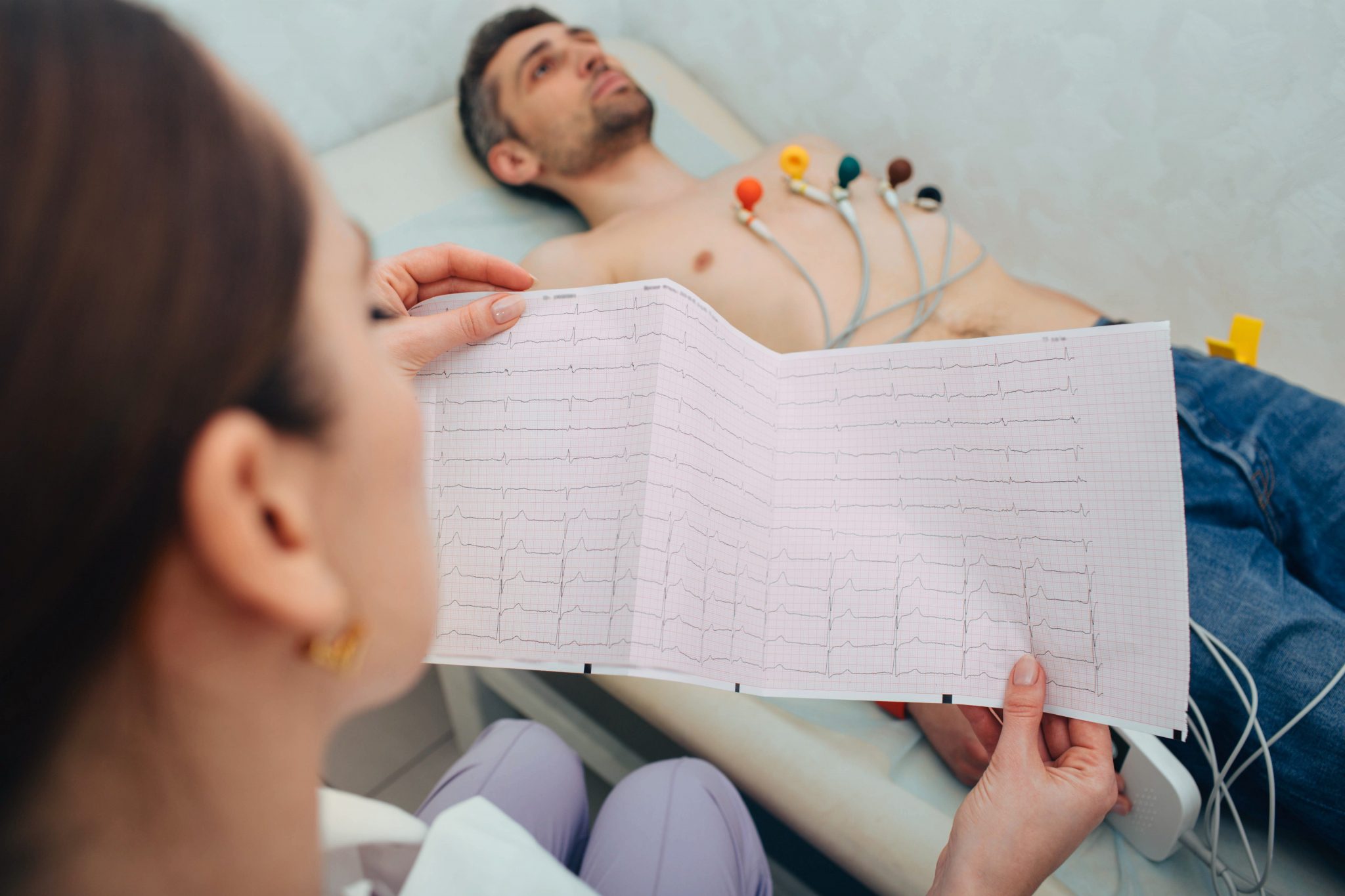An abnormal electrocardiogram (ECG or EKG) means that the electrical activity of the heart, as recorded on the ECG tracing, deviates from the expected or normal patterns. It’s essential to understand that an abnormal ECG is not a diagnosis in itself; rather, it serves as a valuable tool for healthcare providers to identify potential heart-related issues that require further evaluation.
Here are some common reasons why an ECG may be considered abnormal:
Arrhythmias: Arrhythmias are irregular heart rhythms. An ECG can detect various types of arrhythmias, including atrial fibrillation (AFib), ventricular tachycardia (VT), bradycardia (slow heart rate), and others. Arrhythmias can lead to symptoms like palpitations, dizziness, or fainting.
Myocardial Ischemia: Abnormalities in the ECG, such as ST-segment depression or T-wave inversion, can indicate insufficient blood supply to the heart muscle. This condition, known as myocardial ischemia, may be a sign of coronary artery disease (CAD).
 Myocardial Infarction (Heart Attack): A heart attack can result in specific ECG changes, such as ST-segment elevation or the development of pathological Q waves. These changes may indicate damage to the heart muscle due to reduced blood flow.
Myocardial Infarction (Heart Attack): A heart attack can result in specific ECG changes, such as ST-segment elevation or the development of pathological Q waves. These changes may indicate damage to the heart muscle due to reduced blood flow.
Conduction Abnormalities: ECG abnormalities can also reveal issues with the heart’s electrical conduction system, such as bundle branch blocks or heart block. These conditions can affect the heart’s ability to transmit electrical signals efficiently.
Hypertrophy: An abnormal ECG can suggest left ventricular hypertrophy (LVH) or right ventricular hypertrophy (RVH), which are conditions characterized by thickening of the heart muscle in response to increased workload.
Electrolyte Imbalances: Disturbances in blood electrolyte levels, such as low potassium (hypokalemia) or high calcium (hypercalcemia), can manifest as ECG abnormalities, potentially leading to arrhythmias.
Drugs and Medications: Certain medications, including some used to manage arrhythmias or hypertension, can cause ECG changes. It’s essential for healthcare providers to monitor ECGs in individuals taking such medications.
Structural Heart Abnormalities: ECG may reveal structural heart abnormalities such as atrial or ventricular septal defects, which are congenital heart conditions present from birth.
Pericarditis: Inflammation of the pericardium, the sac surrounding the heart, can lead to specific ECG changes, such as PR-segment depression or diffuse ST-segment elevations.
Non-Cardiac Factors: Sometimes, factors unrelated to the heart, such as muscle artifacts, improper lead placement, or patient movement, can lead to abnormal ECG readings. These are usually corrected with proper ECG technique.
It’s crucial to emphasize that an abnormal ECG alone does not provide a definitive diagnosis but serves as a valuable screening tool. Further evaluation, which may include additional tests like echocardiography, stress tests, or blood work, is typically needed to determine the underlying cause and appropriate treatment.
Patients with abnormal ECGs should consult with a healthcare provider, often a cardiologist, who can assess the ECG findings in the context of their medical history, symptoms, and other diagnostic tests. Timely evaluation and diagnosis are essential for appropriate management and the prevention of potential heart-related complications. One of the most common ECG (electrocardiogram) abnormalities seen in adults is atrial fibrillation (AFib). Atrial fibrillation is an arrhythmia characterized by irregular and often rapid heartbeats. In AFib, the atria (the upper chambers of the heart) quiver or fibrillate instead of contracting normally. This irregular electrical activity can lead to an irregular pulse and an ECG that shows erratic and irregular waves.
Key characteristics of atrial fibrillation on an ECG include:
- Absence of P Waves: Instead of clear, organized P waves representing atrial contraction, AFib typically shows chaotic and irregular fibrillatory waves.
- Irregular R-R Intervals: The distance between QRS complexes (R-R intervals) varies irregularly, indicating an irregular heart rate.
- Narrow QRS Complex: The ventricular response in AFib often results in a normal QRS complex duration, as long as the atrioventricular (AV) node conducts the irregular impulses appropriately.
Atrial fibrillation is a significant concern because it increases the risk of stroke due to blood pooling in the quivering atria, which can form clots that can travel to the brain. Additionally, AFib can lead to other complications, including heart failure and an increased risk of other arrhythmias. It’s important to note that while atrial fibrillation is one of the most common ECG abnormalities in adults, there are various other ECG findings and arrhythmias that healthcare providers may encounter, each with its own clinical significance and management approach. An accurate diagnosis and appropriate treatment are crucial for individuals with ECG abnormalities, and these should be determined by a healthcare professional, often a cardiologist, based on a thorough evaluation of the patient’s medical history, symptoms, and additional diagnostic tests.



 ECGs serve a vital role in healthcare for several reasons:
ECGs serve a vital role in healthcare for several reasons: Myocardial Infarction (Heart Attack): A heart attack can result in specific ECG changes, such as ST-segment elevation or the development of pathological Q waves. These changes may indicate damage to the heart muscle due to reduced blood flow.
Myocardial Infarction (Heart Attack): A heart attack can result in specific ECG changes, such as ST-segment elevation or the development of pathological Q waves. These changes may indicate damage to the heart muscle due to reduced blood flow.
